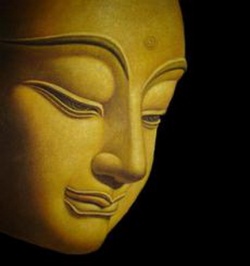Three paths
Earthly desires, karma, and suffering. They are called "paths" because one leads to the other. Earthly desires, which include greed, anger, foolishness, arrogance, and doubt, give rise to actions that create evil karma. The effect of this evil karma then manifests itself as suffering. Suffering aggravates earthly desires, leading to further misguided action, which in turn brings on more evil karma and suffering. Trapped in this cycle, people are destined to suffer in the lower states of existence known as the six paths. In this way, maintaining a self-perpetuating causal relationship, the three paths function to prevent a person from attaining Buddhahood.
In The Profound Meaning of the Lotus Sutra and Great Concentration and Insight, T'ient'ai (538-597) states that the three paths of earthly desires, karma, and suffering are none other than the three virtues of the Dharma body, wisdom, and emancipation. In The Entity of the Mystic Law, Nichiren (1222-1282) states, "Such persons, who honestly discard expedient means, put faith in the Lotus Sutra alone, and chant Nam-myoho-renge-kyo, will transform the three paths of earthly desires, karma, and suffering into the three virtues of the Dharma body, wisdom, and emancipation" (420).The three virtues are inseparable from the three paths. One cannot acquire the three virtues apart from the three paths. Therefore there is no need to eliminate the three paths; all one has to do is to manifest the true nature of the three paths, which is ultimately the three virtues. T'ient'ai pointed out that the true nature of the three paths is none other than the three virtues, while Nichiren taught that the three virtues are potential within the three paths, and become manifest from among them.
(2)[三途](Jpn san-zu ): The path of fire, the path of swords, and the path of blood. The term is used synonymously with the three evil paths of hell, hungry spirits, and animals, and represents the suffering one must undergo in retribution for evil karma one created in a previous life. The path of fire is identified as the world of hell because raging flames devour one's body; the path of swords is identified as the world of hungry spirits because it is said that in that world one is subject to attack by swords; and the path of blood is identified as the world of animals because beings there kill and devour one another.
(3)[三道](Jpn san-do ): Also, three ways. Three stages of practice in the Hinayana teachings.The way of insight, the way of practice, and the way of the arhat, or one who has no more to learn.See three ways.
